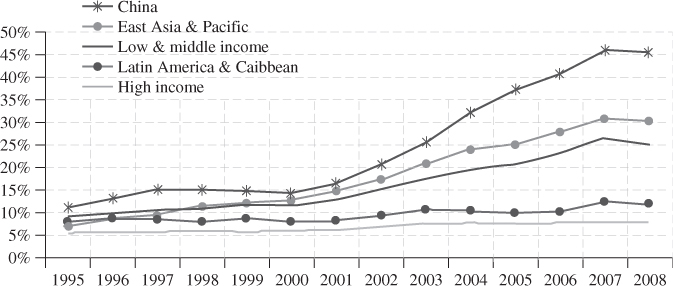26.2 Official FX Interventions and Reserve Accumulation: Stylized Facts, Motives, and Effects
The accumulation of foreign exchange reserves by the monetary authorities of emerging and developing economies is back on the international policy agenda. After the Asian financial crisis of 1997, international reserve accumulation accelerated rapidly, reaching as much as 13% of global GDP in 2009. While the increase in the stocks of FX reserves as a share of GDP of the high income countries has been relatively small (from 6% in 1999 to <8% in 2008), the rise in the ratio of reserves-to-GDP of the low and middle income countries (from 12% to 25%), in particular in East Asia (from 12% to 30%) and especially of China (from 15% to 45%), has been striking (Fig. 26.1).
Figure 26.1 International reserves as a share of GDP (%), 1995–2008. Source: World Development Indicators Mileva (2010).

Following the 2007–2009 global financial crisis, this process has experienced a new acceleration, following a short-lived episode of reserve depletion between end-2008 and the beginning of 2009. The overall level of reserves in EMEs alone reached over USD 6 trillion in mid-2010, USD 1 trillion more than at the peak before the 2007–2009 financial crisis.
How should one assess this rapid pace of official FX interventions and reserve accumulation? What are the motives behind this massive intervention activity? ...
Get Handbook of Exchange Rates now with the O’Reilly learning platform.
O’Reilly members experience books, live events, courses curated by job role, and more from O’Reilly and nearly 200 top publishers.

